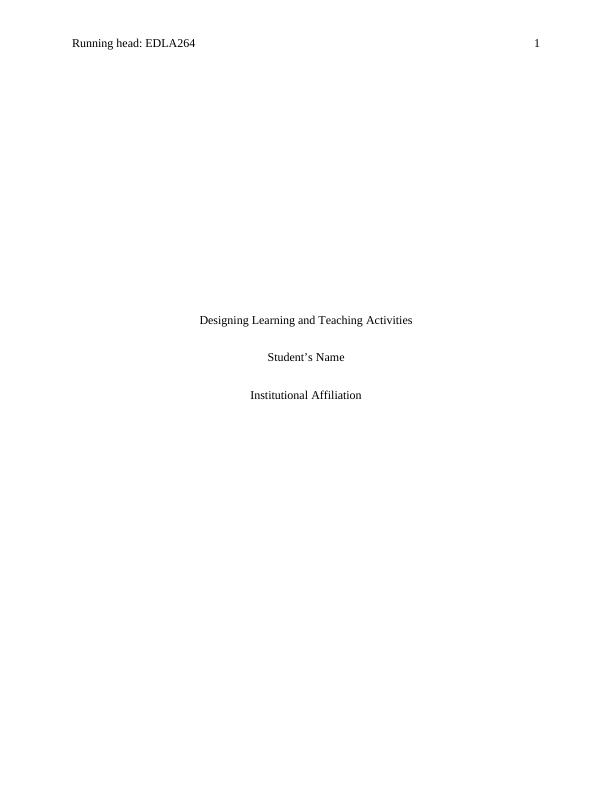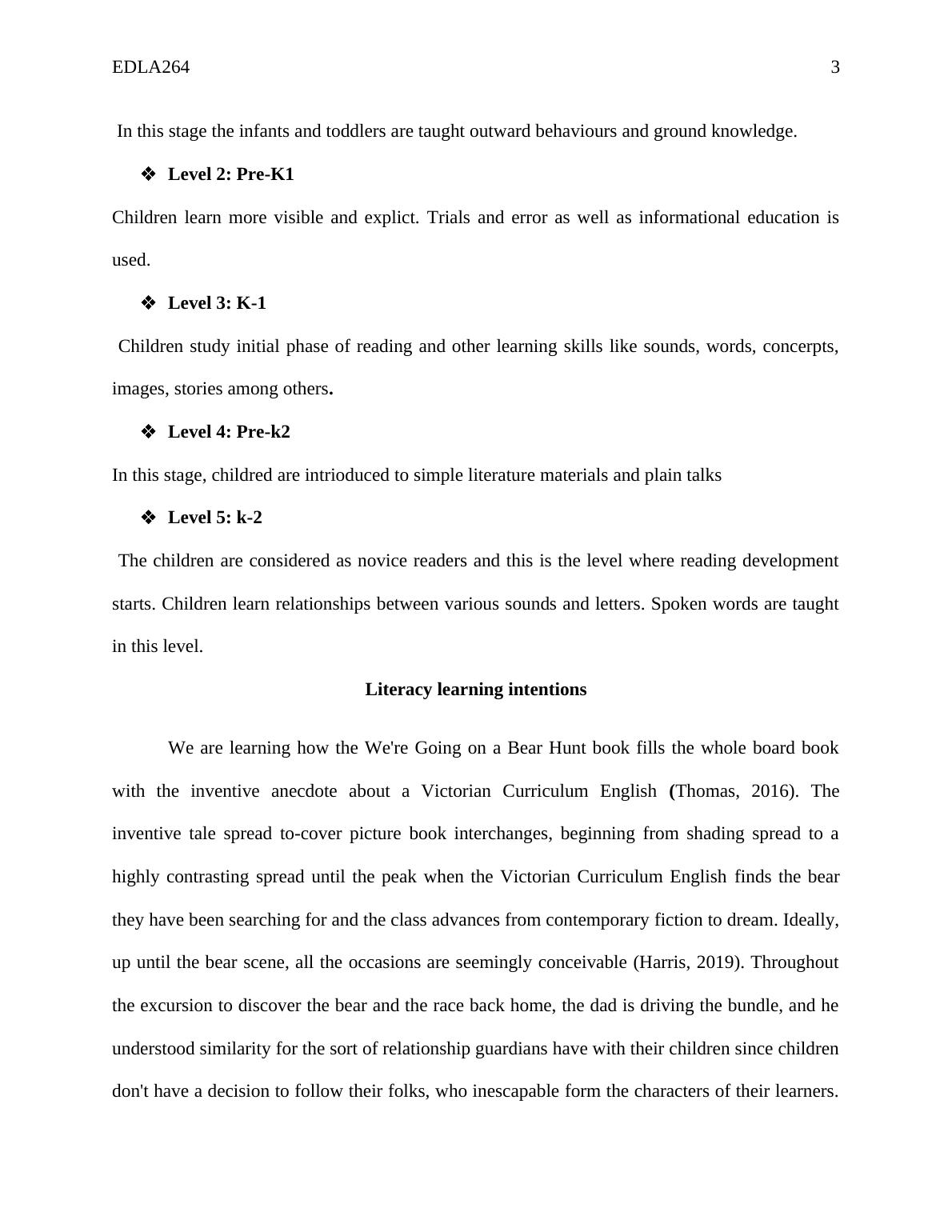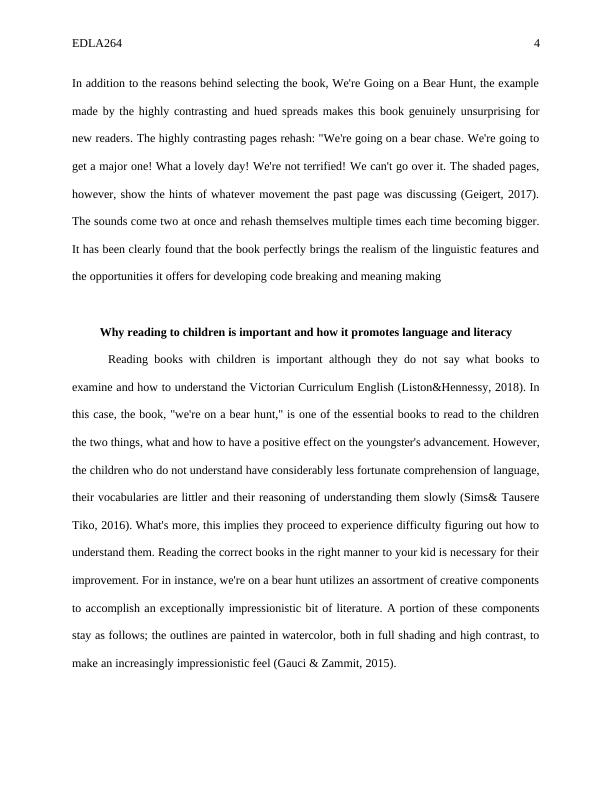Designing Learning and Teaching Activities | Assignment
Added on 2022-09-08
12 Pages3223 Words26 Views
Running head: EDLA264 1
Designing Learning and Teaching Activities
Student’s Name
Institutional Affiliation
Designing Learning and Teaching Activities
Student’s Name
Institutional Affiliation

EDLA264 2
Designing Learning and Teaching Activities
Part A
Designing learning activities, as well as teaching activities, is critical in any teaching
practice to impact effectiveness in the teaching process in the Australian curriculum. In this
designing, the K-2 based children are targeted within the age of 4 turning 5. The design must
coincide with the learning objectives, ensuring the understanding of learners in all directions
with linguistic features (Airs & Ball, 2010). Besides, the plan for assessment of the purpose,
mechanism, and the feedback provision from the students is necessary for such an activity. Most
importantly, technology as a tool to apply in practice is a factor to consider. Following the book,
"we're going on a bear hunt," the teaching and learning design should focus on children's
objective of developing creative-thinking, literacy, and language while dramatizing and
extending the story in the book (Hampshire, 2010). Ideally, the interpretation of the book's
classic hand-rhyme informs about the engagement of the children as well as their fathers while
embarking on the fantasy within the bear hunt. The book, "we're going on a bear hunt," is vital
for the baby class learners as my target group. The video plays a crucial role in captivating and
promoting the children's reading the Australian curriculum.
K-2 stages of reading development as per the Australian curriculum
Learning starts back at home when children are still toddlers and infants. This k-2 is
higher stage of learning developemnt as per the Australian curriculum and early stages of
learning process. The following are some of the levels of the learning development up to K-2.
Level 1: Toddlers and infants level
Designing Learning and Teaching Activities
Part A
Designing learning activities, as well as teaching activities, is critical in any teaching
practice to impact effectiveness in the teaching process in the Australian curriculum. In this
designing, the K-2 based children are targeted within the age of 4 turning 5. The design must
coincide with the learning objectives, ensuring the understanding of learners in all directions
with linguistic features (Airs & Ball, 2010). Besides, the plan for assessment of the purpose,
mechanism, and the feedback provision from the students is necessary for such an activity. Most
importantly, technology as a tool to apply in practice is a factor to consider. Following the book,
"we're going on a bear hunt," the teaching and learning design should focus on children's
objective of developing creative-thinking, literacy, and language while dramatizing and
extending the story in the book (Hampshire, 2010). Ideally, the interpretation of the book's
classic hand-rhyme informs about the engagement of the children as well as their fathers while
embarking on the fantasy within the bear hunt. The book, "we're going on a bear hunt," is vital
for the baby class learners as my target group. The video plays a crucial role in captivating and
promoting the children's reading the Australian curriculum.
K-2 stages of reading development as per the Australian curriculum
Learning starts back at home when children are still toddlers and infants. This k-2 is
higher stage of learning developemnt as per the Australian curriculum and early stages of
learning process. The following are some of the levels of the learning development up to K-2.
Level 1: Toddlers and infants level

EDLA264 3
In this stage the infants and toddlers are taught outward behaviours and ground knowledge.
Level 2: Pre-K1
Children learn more visible and explict. Trials and error as well as informational education is
used.
Level 3: K-1
Children study initial phase of reading and other learning skills like sounds, words, concerpts,
images, stories among others.
Level 4: Pre-k2
In this stage, childred are intrioduced to simple literature materials and plain talks
Level 5: k-2
The children are considered as novice readers and this is the level where reading development
starts. Children learn relationships between various sounds and letters. Spoken words are taught
in this level.
Literacy learning intentions
We are learning how the We're Going on a Bear Hunt book fills the whole board book
with the inventive anecdote about a Victorian Curriculum English (Thomas, 2016). The
inventive tale spread to-cover picture book interchanges, beginning from shading spread to a
highly contrasting spread until the peak when the Victorian Curriculum English finds the bear
they have been searching for and the class advances from contemporary fiction to dream. Ideally,
up until the bear scene, all the occasions are seemingly conceivable (Harris, 2019). Throughout
the excursion to discover the bear and the race back home, the dad is driving the bundle, and he
understood similarity for the sort of relationship guardians have with their children since children
don't have a decision to follow their folks, who inescapable form the characters of their learners.
In this stage the infants and toddlers are taught outward behaviours and ground knowledge.
Level 2: Pre-K1
Children learn more visible and explict. Trials and error as well as informational education is
used.
Level 3: K-1
Children study initial phase of reading and other learning skills like sounds, words, concerpts,
images, stories among others.
Level 4: Pre-k2
In this stage, childred are intrioduced to simple literature materials and plain talks
Level 5: k-2
The children are considered as novice readers and this is the level where reading development
starts. Children learn relationships between various sounds and letters. Spoken words are taught
in this level.
Literacy learning intentions
We are learning how the We're Going on a Bear Hunt book fills the whole board book
with the inventive anecdote about a Victorian Curriculum English (Thomas, 2016). The
inventive tale spread to-cover picture book interchanges, beginning from shading spread to a
highly contrasting spread until the peak when the Victorian Curriculum English finds the bear
they have been searching for and the class advances from contemporary fiction to dream. Ideally,
up until the bear scene, all the occasions are seemingly conceivable (Harris, 2019). Throughout
the excursion to discover the bear and the race back home, the dad is driving the bundle, and he
understood similarity for the sort of relationship guardians have with their children since children
don't have a decision to follow their folks, who inescapable form the characters of their learners.

EDLA264 4
In addition to the reasons behind selecting the book, We're Going on a Bear Hunt, the example
made by the highly contrasting and hued spreads makes this book genuinely unsurprising for
new readers. The highly contrasting pages rehash: "We're going on a bear chase. We're going to
get a major one! What a lovely day! We're not terrified! We can't go over it. The shaded pages,
however, show the hints of whatever movement the past page was discussing (Geigert, 2017).
The sounds come two at once and rehash themselves multiple times each time becoming bigger.
It has been clearly found that the book perfectly brings the realism of the linguistic features and
the opportunities it offers for developing code breaking and meaning making
Why reading to children is important and how it promotes language and literacy
Reading books with children is important although they do not say what books to
examine and how to understand the Victorian Curriculum English (Liston&Hennessy, 2018). In
this case, the book, "we're on a bear hunt," is one of the essential books to read to the children
the two things, what and how to have a positive effect on the youngster's advancement. However,
the children who do not understand have considerably less fortunate comprehension of language,
their vocabularies are littler and their reasoning of understanding them slowly (Sims& Tausere
Tiko, 2016). What's more, this implies they proceed to experience difficulty figuring out how to
understand them. Reading the correct books in the right manner to your kid is necessary for their
improvement. For in instance, we're on a bear hunt utilizes an assortment of creative components
to accomplish an exceptionally impressionistic bit of literature. A portion of these components
stay as follows; the outlines are painted in watercolor, both in full shading and high contrast, to
make an increasingly impressionistic feel (Gauci & Zammit, 2015).
In addition to the reasons behind selecting the book, We're Going on a Bear Hunt, the example
made by the highly contrasting and hued spreads makes this book genuinely unsurprising for
new readers. The highly contrasting pages rehash: "We're going on a bear chase. We're going to
get a major one! What a lovely day! We're not terrified! We can't go over it. The shaded pages,
however, show the hints of whatever movement the past page was discussing (Geigert, 2017).
The sounds come two at once and rehash themselves multiple times each time becoming bigger.
It has been clearly found that the book perfectly brings the realism of the linguistic features and
the opportunities it offers for developing code breaking and meaning making
Why reading to children is important and how it promotes language and literacy
Reading books with children is important although they do not say what books to
examine and how to understand the Victorian Curriculum English (Liston&Hennessy, 2018). In
this case, the book, "we're on a bear hunt," is one of the essential books to read to the children
the two things, what and how to have a positive effect on the youngster's advancement. However,
the children who do not understand have considerably less fortunate comprehension of language,
their vocabularies are littler and their reasoning of understanding them slowly (Sims& Tausere
Tiko, 2016). What's more, this implies they proceed to experience difficulty figuring out how to
understand them. Reading the correct books in the right manner to your kid is necessary for their
improvement. For in instance, we're on a bear hunt utilizes an assortment of creative components
to accomplish an exceptionally impressionistic bit of literature. A portion of these components
stay as follows; the outlines are painted in watercolor, both in full shading and high contrast, to
make an increasingly impressionistic feel (Gauci & Zammit, 2015).

End of preview
Want to access all the pages? Upload your documents or become a member.
Related Documents
Literacy Resource Teaching Kitlg...
|21
|4167
|7
Curriculum Studies: Teaching Mathematics and EC Numeracy Learning Kitlg...
|25
|3343
|319
Connection to Country: Teaching Aboriginal Heritage to Studentslg...
|4
|963
|194
